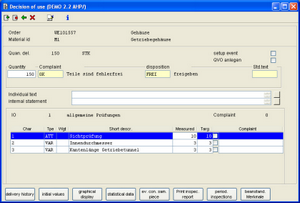The Receiving Inspection
iQ-Basis contains several modules to guarantee a high degree of quality for supplier deliveries.
They focus on different objectives and quality strategies.
The module iQ-WEP(Wareneingangsprüfung, receiving inspection) fulfils the classical requirements
with respect to the receiving inspection, which is mainly based on statistical methods.
Main Characters of Inspection Planning
- inspection plan for variants
- preconditions for additional supplier information
- serial No.
- charge information
- producer specifications
- user specific notes
-
preconditions for dynamic strategies of sample sizes on inspection operation level
may become relevant for all characters of this operation
- these strategies may be changed according to each character; all sample strategies can be defined by the user
- No. of strategies unlimited
- No. of inspection levels (reduced, normal, tightened etc.) unlimited
- Skip control for each character
- limiting the dynamisation by pre-setting levels (most reduced, most increased)
- preconditioning of the starting level
- standardised: DIN/ISO 40080, 3951, BOSCH-Methods, military standard 105, 404 etc.
- constant sample sizes
- AQL tables
If you have suppliers with ppm and zero-defect-contracts, you should prefer the module iQ-EWEP (Ereignisgesteuerte Wareneingangsprüfung; event controlled receiving inspection). Then the quality has to be (and will be) very high, statistical methods do not apply here. This module has especially been developed to cover these requirements.
Generating Inspection Orders
- online generating of inspections orders
- online link to several production planning systems
- SAP R2 and R3
- BRAIN AS, XPPS
- IBM COPICS
- sträßle, PSK etc.
- several links to individual systems (AS/400, IBM-main frames)
- dynamic import and updating of materials, supplier information from the "server" system
- several information concerning the delivery
- planned/real date of delivery (delivery reliability)
- planned/real quantity of parts (adherence to quantity stipulation)
- all important information about ordering and delivering
- accepted manufacturer
- serial No. of manufacturer
- charge information
- manually generated inspection orders
- assignment of plans to parts while entering material or inspection plan
- if more than one plan or more than one valid engineering change (overlapping is permitted) is active, the valid plans or ECs are displayed for selection
- use of total plans (see iQ-PLAN)
- if no information about a plan, than the system standard plan is used
Changing the Inspection Order

- typical changes concerning
- inspection places
- specification limits
- character attributes
- sample sizes
- adding unplanned characters during inspection
Control of Inspection Orders
- assignment of inspection operations to inspection groups or single places (profile projection, x-ray analysis etc.)
- controlling of priorities and planned dates
- capacity planning
Inspection
- controlling of information about delivery or inspection links (has to be/may be read and acknowledged)
- controlling of text input in case of irregularities
- sample size evaluation according to the quantity history about this part
- if inspector is uncertain about quality (close to the specification limits) he may inspect more parts than suggested
- forcing to add additional information, preconditioned to the inspection plan (serial No., charge etc.)
- additional information about the sample
- additional information about each part checked
- distinguishing internal/external information
- inspection of quality characters, entering amount of parts to each discovered defect
- classifying defects by defect groups and codes
- checking quantity characters against plausibility and specification limits
- inspection flow
- gauge bound handling (horizontal)
- sample bound handling (vertical)
- selection of characters or immediate display of next character to be inspected
- picture based inspection
- show the location to be inspected
- more than one picture (still to be accepted, no longer accepted)
- zooming
- comparing samples directly
- Knowledge Base of Inspectors
- inspectors build their own catalogue of defects discovered (very limited inspection planning required)
- assignment of defects to this part of this supplier
- overview of all problems discovered already
- information about repetitive defects
- actuality of defects
- adding new defects
- adding unplanned characters
Use Decision
- controlling of automatically generated decision if no defect occurred
- if defects occurred the inspection result can be analysed with respect to
- the history of this part
- characters with initial values displayed
- overview of individually added description of defects
- statistical evaluations of sample
- decision of use concerning subtotals of quantities (100 free, 50 to be sent back etc.)
- reasons about decision for each group of parts
- disposition of parts
- individual and standard texts for each partial decision for complaints report
- automatically return of disposition orders and quantities to the production planning system
- comprehensive history about all deliveries of one material
- receiving inspection together with initial inspection, repeated inspection, complaints etc.
- quality documentation on character level (compressed data, no initial values)
- decisions and reasoning (deliveries)
- history about non- inspected (time-lag) or skiplots
Several other functions concerning the receiving inspection are described in the flyer of the module iQ-PAUF.